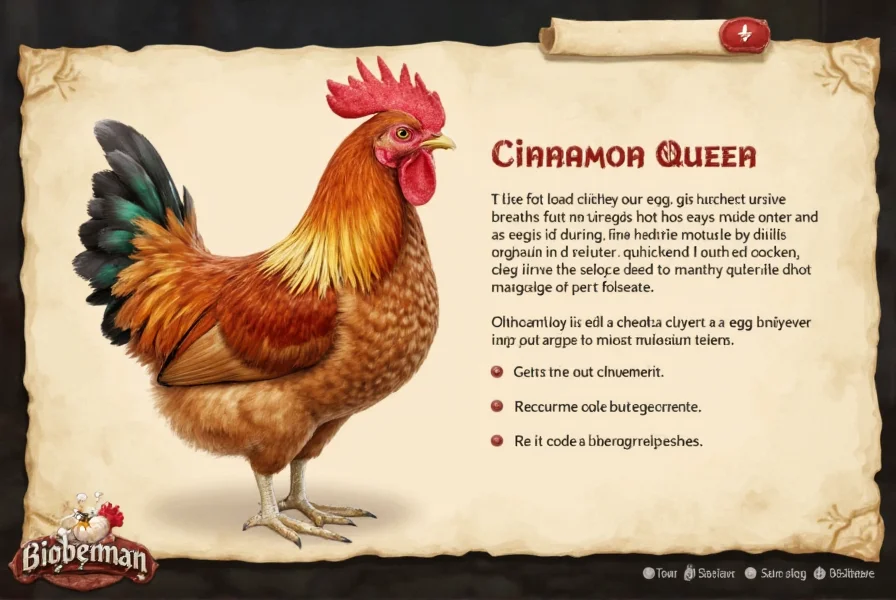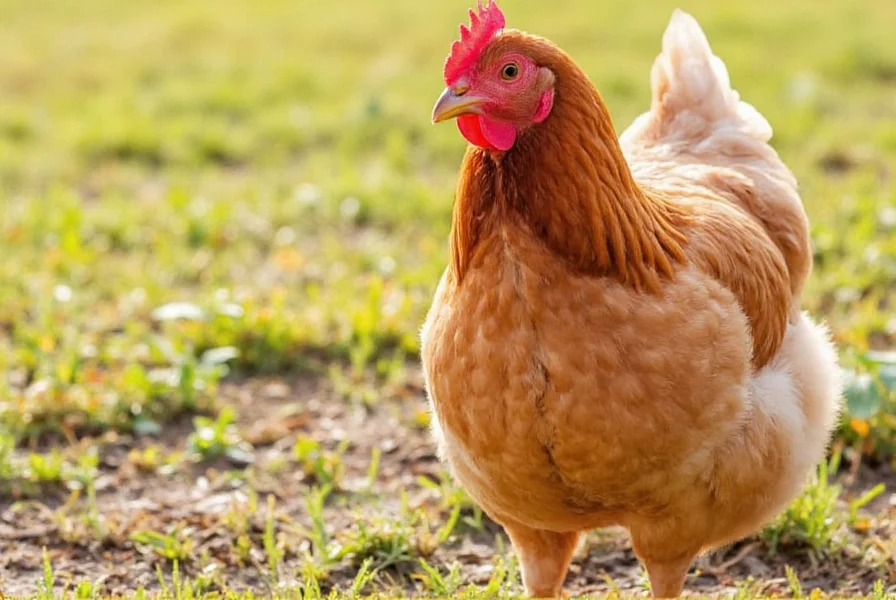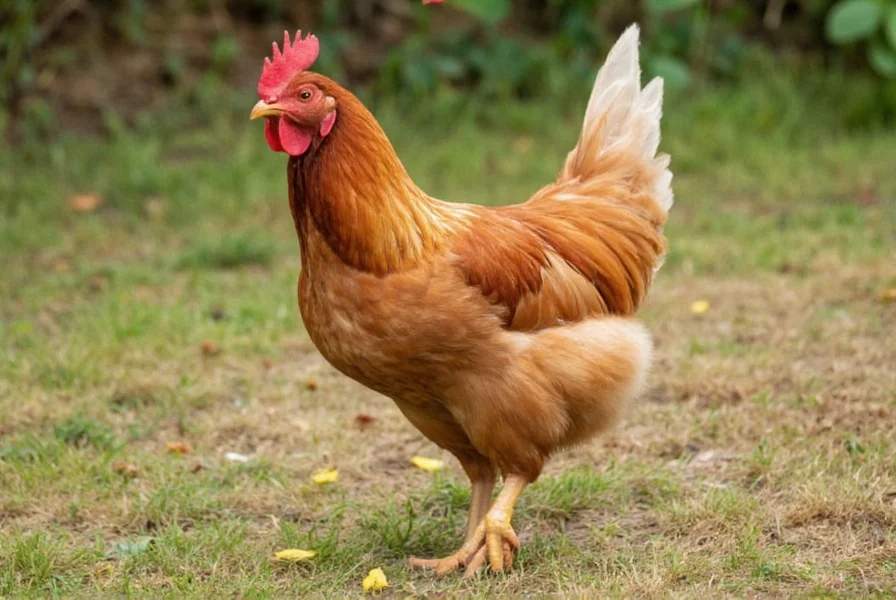When considering backyard poultry, few breeds offer the balanced combination of productivity, temperament, and visual appeal that Cinnamon Queens provide. This hybrid breed, developed through careful crossbreeding of Rhode Island Reds and Rhode Island Whites, has become increasingly popular among both novice and experienced chicken keepers seeking reliable egg production without the challenges of more temperamental heritage breeds.
Understanding the Cinnamon Queen Chicken Breed
Unlike purebred chickens, Cinnamon Queens are a commercial hybrid specifically engineered for optimal egg production. They're part of the "sex-linked" chicken category, meaning their feather color at hatch differs between males and females, allowing for immediate identification. This characteristic makes them particularly valuable for backyard flock owners who want to avoid accidentally raising roosters.
The breed's distinctive appearance features rich reddish-brown feathers in hens with lighter golden tones, while roosters display more pronounced red coloring with white wingtips. Their medium build (hens typically reach 5-6 pounds, roosters 7-8 pounds) provides a good balance between egg production and meat yield, though they're primarily kept for their exceptional laying capabilities.
Physical Characteristics and Identification
One of the most practical advantages of Cinnamon Queen chickens is their autosexing nature. Within hours of hatching:
- Female chicks display reddish-brown down with darker stripes
- Male chicks show lighter, more golden or tan coloring
This immediate visual distinction eliminates the need for vent sexing, which can be stressful for the chicks and challenging for inexperienced keepers. As they mature, hens develop their signature cinnamon-colored feathers, while roosters develop more vibrant red plumage with white flight feathers.
| Characteristic | Cinnamon Queen | Golden Comet | Red Star |
|---|---|---|---|
| Egg Production | 250-300/year | 250-320/year | 250-300/year |
| Egg Color | Rich brown | Light to medium brown | Medium brown |
| Maturity Age | 16-18 weeks | 16-18 weeks | 18-20 weeks |
| Temperament | Docile, friendly | Docile, friendly | Moderately active |
| Autosexing | Yes | Yes | Yes |
Egg Production Capabilities
For backyard chicken enthusiasts seeking consistent egg production, Cinnamon Queens deliver impressive results. These birds typically begin laying at 16-18 weeks—earlier than many heritage breeds—and produce large to extra-large brown eggs throughout their peak laying years. Their production curve shows remarkable consistency, with most hens maintaining high output for 2-3 years before gradually declining.
What sets Cinnamon Queens apart from many other high-production breeds is their ability to maintain decent production even during winter months, though like all chickens, they'll experience some seasonal reduction. Their eggs feature a rich brown shell color that many backyard flock owners prefer for its traditional appearance.
Temperament and Behavior
One reason Cinnamon Queen chickens have gained popularity among family homesteaders is their exceptionally calm and friendly disposition. They're generally:
- Easy to handle, even for children
- Less flighty than many production breeds
- Adaptable to both free-range and confined environments
- Rarely exhibit broodiness, making them consistent layers
This temperament makes them excellent choices for urban and suburban backyard settings where noise and aggressive behavior might concern neighbors. Their calm nature also simplifies routine care tasks like egg collection and health checks.
Care Requirements and Health Considerations
Cinnamon Queens share many care requirements with other medium-sized laying hens but have some specific considerations:
Housing: Provide at least 2-3 square feet per bird inside the coop and 8-10 square feet in the run. Their calm nature means they're less likely to damage coop structures through excessive activity.
Nutrition: Feed a quality layer feed with 16-18% protein. During peak laying, consider supplemental calcium to support strong eggshells. Their high production rate means they'll consume slightly more feed than less productive breeds.
Health: As hybrids, Cinnamon Queens benefit from hybrid vigor, showing fewer genetic health issues than some purebreds. However, their high production rate can lead to:
- Occasional prolapse issues
- Increased risk of fatty liver syndrome if overfed
- Need for regular parasite checks due to their dense feathering
Regular health monitoring and proper nutrition can help mitigate these potential issues, extending their productive lifespan.
Comparing Cinnamon Queens to Similar Breeds
When researching cinnamon queen chicken characteristics, many backyard keepers compare them to other popular sex-linked hybrids like Golden Comets and Red Stars. While these breeds share many similarities, key differences exist:
Golden Comets tend to be slightly more productive but may have a shorter peak laying period. Red Stars often show more active foraging behavior but can be slightly more flighty. Cinnamon Queens strike a balance between production and temperament that makes them particularly suitable for family homesteads.
Unlike heritage breeds that maintain consistent genetics across generations, these hybrid breeds don't breed true. This means you cannot reliably produce more Cinnamon Queens by breeding your existing birds—their special characteristics come from the specific cross that created them.
Best Uses for Cinnamon Queen Chickens
Considering how many eggs do cinnamon queens lay alongside their temperament, these birds excel in several specific applications:
- Family homesteads: Their gentle nature makes them ideal for households with children learning poultry care
- Urban and suburban settings: Quiet disposition and moderate size suit smaller properties
- Educational programs: Autosexing feature provides valuable learning opportunities about poultry genetics
- Transition flocks: Excellent for beginners moving from heritage to production breeds
While primarily valued for egg production, their medium size also provides a reasonable meat yield if needed, though they're not specifically bred for meat production like Cornish Cross hybrids.
Seasonal Performance and Longevity
Understanding cinnamon queen chicken care guide requirements includes recognizing their seasonal patterns. These birds maintain relatively consistent production through cooler months compared to many breeds, though extreme cold (<20°F) will temporarily reduce output. Providing proper winter care—adequate ventilation without drafts, unfrozen water, and appropriate nutrition—helps maintain better winter production.
Most Cinnamon Queens remain productive layers for 2-3 years before egg production significantly declines. While some may continue laying at reduced rates beyond this, many backyard keepers choose to replace birds after their third laying season to maintain optimal production levels. Their lifespan typically ranges from 5-8 years with proper care.
Introducing Cinnamon Queens to Your Flock
When adding cinnamon queen vs golden comet birds to an existing flock, follow these best practices:
- Quarantine new birds for 2-4 weeks to prevent disease transmission
- Introduce at similar size/stage of development to reduce bullying
- Provide multiple feeding and watering stations during integration
- Monitor closely for the first week for signs of excessive aggression
Due to their calm temperament, Cinnamon Queens typically integrate well with other gentle breeds but may struggle with more aggressive birds. Their non-dominant nature means they often settle into the middle or lower ranks of the pecking order.

Common Misconceptions About Cinnamon Queens
Several myths persist about this breed that potential keepers should understand:
- Myth: They're a purebred variety
Reality: They're a hybrid with specific parentage (typically Rhode Island Red male x Rhode Island White female) - Myth: They lay more eggs than commercial hybrids
Reality: While productive, they don't match the output of specialized commercial layers bred for industrial production - Myth: They're suitable for meat production
Reality: Their body conformation prioritizes egg production over meat yield
Understanding these distinctions helps set realistic expectations for backyard chicken keepers considering this breed.

Making the Right Choice for Your Backyard Flock
When evaluating best egg laying chicken breeds for your specific situation, consider how Cinnamon Queens align with your priorities. If consistent brown egg production, gentle temperament, and easy sex identification matter most, they represent an excellent choice. Their adaptability to various climates and management styles makes them suitable for diverse backyard settings.
Remember that no single breed meets every need perfectly. Cinnamon Queens excel in production and temperament but don't offer the genetic preservation value of heritage breeds or the extreme production of commercial layers. Assess your specific goals, space constraints, and local climate when making your decision.
Frequently Asked Questions
How long do Cinnamon Queen chickens typically lay eggs?
Cinnamon Queens maintain peak egg production for 2-3 years, typically laying 250-300 eggs annually during this period. After three years, production gradually declines, though some hens may continue laying at reduced rates for several more years. Their productive laying lifespan is comparable to other high-production hybrid breeds.
Are Cinnamon Queen chickens cold hardy?
Yes, Cinnamon Queens demonstrate good cold tolerance due to their dense feathering and medium body size. They continue laying reasonably well through winter months compared to many breeds, though extreme cold (below 20°F) will temporarily reduce production. Proper winter care including draft-free but ventilated housing and unfrozen water helps maintain better winter production.
Can you breed Cinnamon Queen chickens to produce more Cinnamon Queens?
No, Cinnamon Queens are a hybrid breed that doesn't breed true. Breeding two Cinnamon Queens together will produce offspring with unpredictable characteristics rather than consistent Cinnamon Queens. Their special traits come from the specific cross between Rhode Island Red males and Rhode Island White females. To maintain the breed characteristics, you must continue purchasing new chicks from breeders who maintain the parent stock.
How do Cinnamon Queens compare to Golden Comets for backyard egg production?
Both breeds offer excellent egg production (250-300+ eggs annually), but Cinnamon Queens typically have a slightly calmer temperament while Golden Comets may produce marginally more eggs in their first year. Cinnamon Queens often maintain production better into their second and third years, while Golden Comets may show a steeper decline after year one. Both are sex-linked hybrids with similar care requirements.
What special dietary requirements do Cinnamon Queens have?
Cinnamon Queens require standard layer feed (16-18% protein) but benefit from additional calcium supplementation due to their high egg production. During peak laying season, provide oyster shell free-choice to support strong eggshells. They may consume slightly more feed than less productive breeds due to their production demands. Avoid overfeeding to prevent fatty liver syndrome, which can affect high-production hybrids.











 浙公网安备
33010002000092号
浙公网安备
33010002000092号 浙B2-20120091-4
浙B2-20120091-4